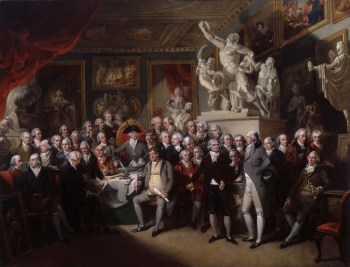Johann Zoffany RA (1733 - 1810)
RA Collection: People and Organisations
An Anglo-German artist, Zoffany was one of the first Royal Academicians, nominated by his friend and patron King George III. Zoffany, however, was no stranger to scandal, and by his forties his daring work had seen him ousted from the King’s favour.
Zoffany was born near Frankfurt in 1733, the son of a master craftsman who served at Prince Karl Anselm’s court in Regensburg. At the age of 17 he resolved to train as an artist and set off for Rome, where he studied with the artist and theorist Anton Raphael Mengs. Zoffany spent several years travelling around Europe painting for various aristocrats, princes and kings, before arriving in London in 1760.
Zoffany initially struggled to establish himself in the upper echelons of society, hindered by the fact that he never became fluent in English. Ultimately two significant patrons secured his financial and commercial success: the actor and playwright David Garrick, and Queen Charlotte. For Garrick, he painted theatrical scenes and portraits that were engraved and turned into prints, helping to popularise his work among the British public. From the mid-1760s to late 1770s, Zoffany also enjoyed royal patronage, completing portraits including Queen Charlotte with her two Eldest Sons and George III, Queen Charlotte and their six eldest children.
This close relationship with the royal family secured Zoffany’s inclusion in the newly formed Royal Academy of Arts, appointed by the King as a “nominated member” in 1769. Between 1771-72, Zoffany completed The Academicians of the Royal Academy, a painting showing the first Royal Academicians – the male artists setting up a life-drawing class, while two female members (Angelica Kauffman and Mary Moser) were represented by portraits on the walls.
In 1772, The Queen sent Zoffany on a lucrative commission to Italy. He laboured over one work for six years, eventually revealing The Tribuna of the Uffizi in 1779. Unfortunately, this particular work – and its inclusion of what The queen understood to be homosexual young men – shocked the royal family into severing ties with Zoffany. The work caused a major scandal, but his daring should perhaps have been less surprising given that in the same year, Zoffany unveiled a self-portrait that featured two condoms in the background, hanging next to a rosary.
The breakdown of his royal connection prompted Zoffany to set off abroad once more, sailing to India in 1783. He spent six years in the country, completing masterful group paintings including Colonel Mordaunt’s Cock Match, a colourful depiction of Anglo-Indian society in Lucknow. After returning to London, Zoffany struggled with ill health and his output slowed considerably. His last significant works were responses to the French revolution; two paintings titled Massacre at Paris, completed in 1794. Zoffany died in 1810, aged 77.
Profile
Nominated Member
Born: 13 March 1733 in ?, near Frankfurt-am-Main, Germany
Died: 11 November 1810
Nationality: German, British
Elected RA: 11 December 1769
Gender: Male
Preferred media: Painting
Works by Johann Zoffany in the RA Collection
2 results
Works after Johann Zoffany in the RA Collection
2 results
Works associated with Johann Zoffany in the RA Collection
3 results
-
![Johann Zoffany RA, The Antique School of the Royal Academy at New Somerset House]()
Attributed to Johann Zoffany RA
The Antique School of the Royal Academy at New Somerset House, 1780-1783
Oil on canvas
-
![George Dance RA, Portrait of Johann Zoffany, R.A.]()
George Dance RA
Portrait of Johann Zoffany, R.A., 1 June 1793
Pencil, black and pink chalks, and blue wash on cream wove paper
-
![Henry Singleton, The Royal Academicians in General Assembly]()
Henry Singleton
The Royal Academicians in General Assembly, 1795
Oil on canvas
Associated archives
39 results
-
Johann Zoffany RA Society Observed
2012
Item RAA/PRE/5/2/503
-
J. Northcote, Rome, to Sam. Northcote, Plymouth, Devonshire, England
11 Sep 1778
Item NOR/44
-
James Northcote, to [Samuel Northcote]
19 Dec 1771
Item NOR/6
-
Copies of letter between Ozias Humphry, Macpherson, Francis Magnus his secretary and Colonel Harper
[1786]
Item HU/8/12






